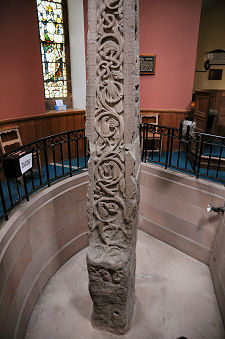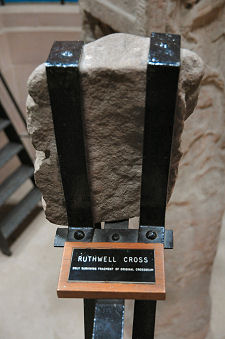Paityn C.
All images courtesy of Undiscovered Scotland.
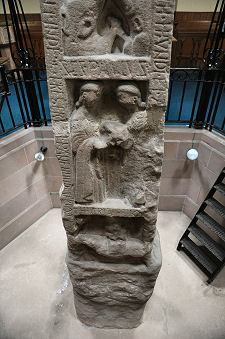
St Paul and St Anthony Sharing Bread
In the 8th century, the Ruthwell Cross, a work of insular art, was created. Insular art is “the artistic tradition which flourished in Britain and Ireland after the departure of the Romans” (British Library). The Ruthwell Cross is a stone cross located in Dumfriesshire, Scotland; it rises about “5.2m or 17 feet tall” (Undiscovered Scotland). It is widely known as “an early Christian monument of international importance” because of the depictions of Jesus Christ engraved onto it (British Library).
The Ruthwell Cross is described as “one of the most impressive monuments to survive from the Anglo-Saxon period” (British Library). It is argued that the cross spent most of its life indoors “sheltered from the elements” (Undiscovered Scotland); however, when I look at the cross, I find that it looks weathered and ill-protected, the engravings are quite faded and no longer “crisp” as some sources describe them to be; therefore, I believe that these assumptions about the cross are false.
The traditional story of the cross claims that it was “originally sited on the shore of the Solway Firth at a place called Priestside, a mile and a half south of Ruthwell Church” (Undiscovered Scotland). In 1640, the General Assembly of the Kirk made a decree stating that “‘many idolatrous monuments erected and made for religious worship’ should be destroyed” (Undiscovered Scotland). This led to the cross being destroyed in 1642 and “its pieces being buried in the clay floor” of the Ruthwell Parish Church (Undiscovered Scotland). The church is said to have been remodelled somewhere between 1801 to 1803. During this time, the fragments of the cross that were buried in the clay floor were collected and reassembled under the order of Reverend Henry Duncan. Many pieces were broken or missing, most of which were easily replaced; however, the cross beam “was almost entirely absent apart from one fragment now shown beside the cross itself” (Undiscovered Scotland). After being reconstructed, the cross found a permanent home inside of the Ruthwell Church in Dumfriesshire, Scotland. The floor of the church where the cross stands had to be recessed in order for the cross to fit vertically inside the church.
There are several carvings found on the Ruthwell Cross that depict significant moments from Jesus Christ’s life. Some of these events are “Christ Standing on a Pair of Animals,” “Mary Magdalene Washing Christ’s Feet,” “St Paul and St Anthony Sharing Bread,” “Healing the Blind Man,” “The Annunciation,” and “The Crucifix Scene” (Undiscovered Scotland).
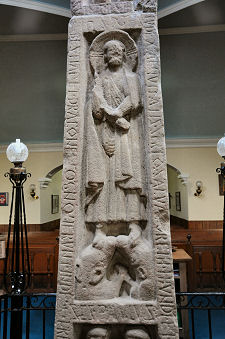
“Christ Standing on a Pair of Animals” (Undiscovered Scotland)
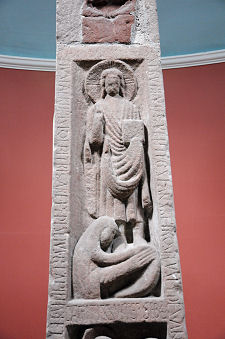
“Mary Magdalene Washing Christ’s Feet” (Undiscovered Scotland)
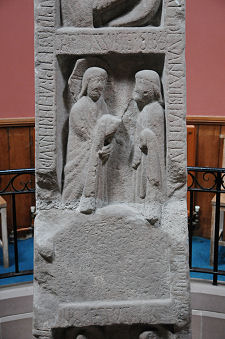
“Healing the Blind Man” (Undiscovered Scotland)
Surrounding the depictions of Jesus Christ’s life are runic inscriptions “in two languages – Old English and Latin” (Lethaby 145). “These runes were able to be “deciphered in the 19th century through the subsequent discovery of the Vercelli manuscript” (Saxl 1). Through this, it was learned that the inscriptions are lines from the poem The Dream of the Rood. “English scholars are agreed that the poem, The Dream of the Rood, is one of the earliest examples of English” (Lethaby 145). “The poem tells the story of the crucifixion of Christ from the perspective of the tree that was cut down to make the cross to which Christ was nailed” (British Library). “It begins with the enemy coming to cut the tree down and carrying it away. The tree learns that it is not to be the bearer of a criminal, but instead Christ crucified. The Lord and the Cross become one, and they stand together as victors, refusing to fall, taking on insurmountable pain for the sake of mankind. It is not just Christ, but the Cross as well that is pierced with nails… the Rood and Christ are one in the portrayal of the Passion – they are both pierced with nails, mocked and tortured… then, just as with Christ, the Cross is resurrected, and adorned with gold and silver. It is honoured above all trees just as Jesus is honoured above all men” (“Dream of the Rood”). I find it incredible that this poem is inscribed on the cross because this makes the Ruthwell Cross “one of the oldest poetic manuscripts in English history” (Lethaby 145).
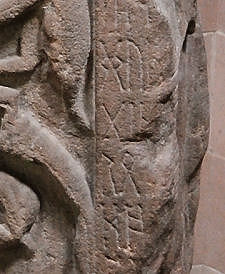
A piece of the cross with runic inscription.
The Ruthwell Cross is a fascinating and controversial mystery. There are debates as to whether or not “it was originally a cross or a pillar” as well as questions regarding “who added the runic inscriptions, when, and why?” As well as, “how accurate was the reconstruction?” (Undiscovered Scotland). Personally, I have a few questions of my own that I am curious to know the answers to, was the cross a conversation tool? Who is the author of The Dream of the Rood? Who engraved the poem onto the cross? Who constructed the cross and why? What did the people use the cross for? Why were the particular scenes that depict Jesus Christ selected? It is likely that I will never get an exact answer to my questions; nonetheless, it is interesting to ponder them.
The Ruthwell Cross is a spectacular and mind-blowing historical monument. The lack of knowledge about its creation and use causes the fascination towards the Ruthwell Cross to increase. Personally, I found this cross to be exquisitely engraved with an attention to detail that should not be ignored. I would highly recommend conducting your own research, looking into and making your own assumptions to the unanswered questions of the monument as well as personally viewing it if you are ever lucky enough to find yourself in Dumfriesshire, Scotland.
Works Cited
“Dream of the Rood.” Wikipedia. 5 September 2018. en.wikipedia.org/wiki/Dream_of_the_Rood.
Lethaby, W. R. “The Ruthwell Cross.” The Burlington Magazine for Connoisseurs, vol. 21, no. 111, 1912, pp. 145–146.
“The Ruthwell Cross.” The British Library. 29 Nov. 2017, www.bl.uk/collection-items/ruthwell-cross.
“Ruthwell Cross.” Undiscovered Scotland. www.undiscoveredscotland.co.uk/ruthwell/ruthwellcross/index.html.
Saxl, F. “The Ruthwell Cross.” Journal of the Warburg and Courtauld Institutes, vol. 6, 1943, 1–19.
Schapiro, Meyer. “The Religious Meaning of the Ruthwell Cross.” The Art Bulletin, vol. 26, 4, 1944, pp. 232–245.
